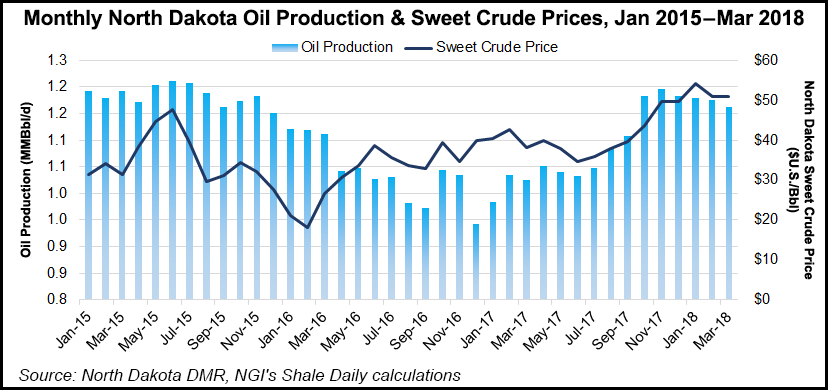Bakken Shale | E&P | NGI All News Access | NGI The Weekly Gas Market Report
Water Disposal Looms as Challenge After Bakken’s Next Growth Phase, State Official Says
Although there are plenty of near-term challenges tied to robust natural gas production and takeaway infrastructure in the Bakken Shale, water disposal in North Dakota is poised to emerge as a major and costly challenge in the longer-term, according to the state’s chief oil and gas regulator.

In an interview with NGI”s Shale Daily at the Williston Basin Petroleum Conference (WBPC) in Bismarck, Lynn Helms, director of the state Department of Mineral Resources, took out his crystal ball, comparing what he expects the Bakken to look like in 2030 to what the Eagle Ford Shale is today with active wells approaching 40,000. The caveat, however, is that North Dakota’s black gold might be tarnished by water limitations, he said.
“The emerging issue I see about that time is water re-use or water disposal,” said Helms, reiterating what he warned about in another context two years ago at the WBPC, calling out state water policy and industry operating practices. “We’ve found that there are localized parts of our disposal zone that have limits, and the oil/gas industry is pushing up against those limits.”
North Dakota now has what Helms called “a major initiative” to map the underground situation, and researchers at North Dakota State University’s Energy and Environmental Research Center (EERC) are developing a web-based model so state water officials can do a better job of monitoring the situation, he said.
Noting that this issue isn’t related to his state’s strong stand against the Obama administration’s Waters of the United States (WOTUS) policy that is being revised by the Trump administration, Helms said the focus now is on a disposal zone about a mile underground, and “are we going to be forced to move a significant part of that [oil and gas wastewater] disposal another 1,200 feet deeper at more cost into a different formation? We haven’t found any technology that allows us to recycle water here.”
Helms said a technological breakthrough in water disposal is very unlikely. “The whole area of water production, disposal, etc., is industry’s number one operating cost, so they need to be focused on that very heavily, and there hasn’t been much focus,” he said. “We haven’t seen the kind of investment and technology development in that area that we have seen in drilling and stimulation.”
Helms expects that by 2030, the Bakken will be at about two-thirds of its ultimate well count, sort of where he sees the Eagle Ford today. “Operating costs — not capital investment — will be the dominant theme then.”
Aside from the rosy long-term projections in which he sees drilling advances leading to faster completions and better production, Helms identified a lot of near-term issues that will need to be addressed to assure the Bakken develops as anticipated.
“I think we are going to see a lot of the things companies have developed in the Eagle Ford come back into the Bakken, different fracture designs and enhanced oil recovery [EOR] processes that will increase our recovery factor per well,”He said, adding that the state’s six-month recovery factor has improved by 70% over the past four years on a well-to-well comparison. “In the Eagle Ford, they have been able to achieve 30-70% improvements in estimated ultimate recovery using different fracturing and EOR methods.”
© 2024 Natural Gas Intelligence. All rights reserved.
ISSN © 2577-9877 | ISSN © 1532-1266 | ISSN © 2158-8023 |
